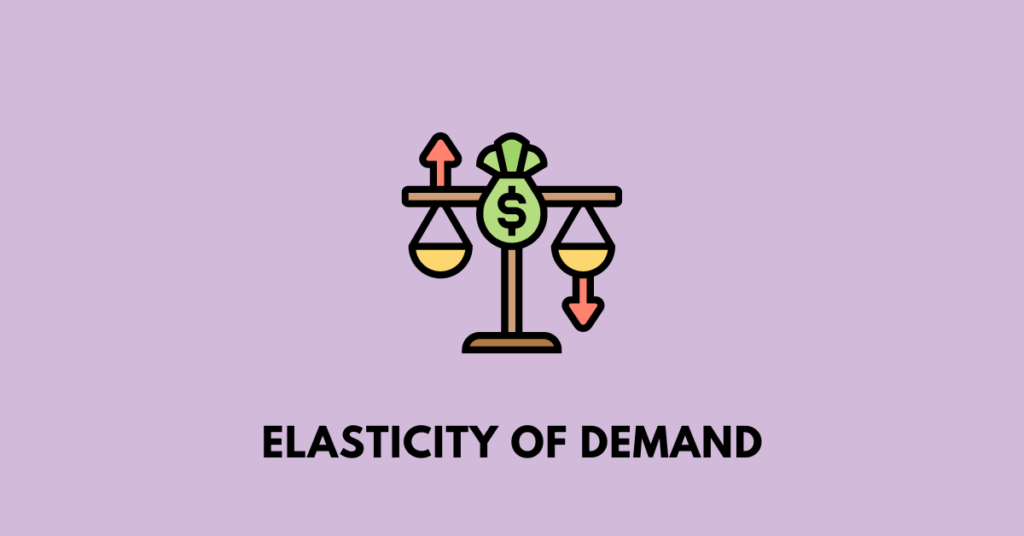Get summaries, questions, answers, solutions, notes, extras, PDF and guide of Class 11 (first year) Economics textbook, chapter 4 Elasticity of Demand of AHSEC Class 11 Economics notes, which is part of the syllabus of students studying under AHSEC/ASSEB (Assam Board). These solutions, however, should only be treated as references and can be modified/changed.
If you notice any errors in the notes, please mention them in the comments
Summary
The chapter on Price Elasticity of Demand explains how changes in price affect the quantity demanded for goods and services. Price elasticity measures how sensitive the demand for a product is to changes in its price. When a small price change leads to a large change in demand, the demand is said to be elastic. If demand hardly changes with a price shift, it is considered inelastic.
Price elasticity is calculated using the percentage method, where the percentage change in quantity demanded is divided by the percentage change in price. There are five types of price elasticity. First, inelastic demand occurs when demand changes by a smaller percentage than the price. For example, essential goods like wheat and salt usually show inelastic demand. Second, elastic demand happens when the quantity demanded changes more than the price, such as with luxury items like air conditioners. Third, unitary elasticity is when demand changes in exact proportion to the price, meaning the total expenditure remains the same. Fourth, perfectly inelastic demand refers to a situation where demand does not change at all, no matter how much the price shifts, resulting in a vertical demand curve. Lastly, perfectly elastic demand is when demand changes infinitely with even the smallest price change, though this is rarely seen in reality.
Several factors influence price elasticity. These include the availability of substitutes, the nature of the good (whether it is a necessity or a luxury), the proportion of income spent on the good, consumer habits, and whether the consumption of the good can be postponed. For example, goods with many close substitutes tend to have more elastic demand. On the other hand, necessary goods like medicines tend to have inelastic demand because people need them regardless of price.
The chapter also covers different methods to measure price elasticity, such as the percentage method, the total expenditure method, and the geometric or point method. The total expenditure method helps determine elasticity by examining how total spending changes when the price changes. If total spending remains unchanged despite a change in price, the demand is said to have unitary elasticity. If total spending decreases as prices rise, demand is elastic, meaning people buy less as prices increase.
Elasticity also plays a role in determining pricing strategies. For goods with elastic demand, lowering the price may increase total revenue since more people will buy the product. For inelastic goods, raising the price might not reduce demand significantly, which could lead to increased revenue.
Elasticity is a useful tool for businesses and governments. It helps them understand how consumers might respond to changes in prices, taxes, or subsidies. This knowledge is important in making decisions about pricing, production, and policies, as it helps predict consumer behaviour in different market conditions.
Textbook solutions
Very Short Answer Type Questions
1. Define the price elasticity of demand.
Answer: Price elasticity of demand refers to the degree of responsiveness of the demand for a good to a change in its price.
2. When is the demand for a commodity said to be inelastic?
Answer: The demand for a commodity is said to be inelastic when the percentage change in the demand for the commodity is less than the percentage change in its price.
3. What would be the price elasticity of demand at the mid-point on a straight-line demand curve?
Answer: The price elasticity of demand at the mid-point on a straight-line demand curve is equal to 1.
4. Mention any two commodities whose demand is less elastic.
Answer: Salt and electricity.
5. Mention any two commodities whose demand is elastic.
Answer: Coke and air-conditioners.
6. Select from the following goods which have inelastic demand.
(a) Car
(b) Textbooks
Answer: Textbooks.
7. Is the demand for the following commodities elastic or inelastic? Give reasons.
(a) Salt
(b) Sony TV
Answer:
(a) Salt has inelastic demand because it is a necessity and has no close substitutes.
(b) Sony TV has elastic demand because it is a luxury item, and substitutes are available.
8. If the price of a commodity is increased by 10% and the total expenditure of the consumer on that commodity remains constant, what is the elasticity of demand?
Answer: The elasticity of demand is unitary elastic.
9. If elasticity of demand is zero and the price of a commodity is decreased by 10%, what will be the change in quantity demanded?
Answer: There will be no change in the quantity demanded.
10. If the percentage change in quantity demanded is equal to the percentage change in price, what is the price elasticity of demand?
Answer: The price elasticity of demand is unitary elastic.
Short Answer Type Questions
1. Explain price elasticity of demand.
Answer: Price elasticity of demand refers to the degree of responsiveness of the demand for a good to a change in its price.
2. How is the price elasticity of demand of a commodity affected by the number of its substitutes?
Answer: If close substitutes of a good are readily available, its price elasticity of demand is likely to be high, because even a very small increase in price will make consumers switch over to other goods in a big way. For example, demand for cold drinks like coca-cola, pepsi, limca, etc., is elastic. In the absence of close substitutes, the elasticity is likely to be small. For example, commodities like electricity and salt have inelastic demand.
3. How does the nature of a commodity influence its price elasticity of demand?
Answer: Nature of the Commodity and Price Elasticity of Demand: If the commodity is a necessity of life (e.g., food, medicine, textbooks, etc.), its demand will not change much when its price changes. Since they have to be purchased even though their prices go up, the elasticity of demand will be low. When a commodity is a comfort, its demand is moderately elastic as consumers can postpone their consumption. The demand for luxury items (e.g., AC, big-sized colour TV sets, etc.) is relatively elastic as they are high-priced commodities.
4. Mention any three factors influencing price elasticity of demand of a commodity. Explain any one of them.
Answer: The three factors influencing price elasticity of demand are:
- Availability of substitutes
- Nature of the commodity
- Proportion of income spent
Availability of substitutes: If close substitutes of a good are readily available, its price elasticity of demand is likely to be high because consumers can easily shift to other goods.
5. Which of the following commodities have inelastic demand?
(a) salt (b) a particular brand of lipstick (c) medicine (d) mobile phone (e) school uniform
Answer: Salt, medicine, and school uniform have inelastic demand.
6. Is the demand for the following commodities elastic or inelastic?
(a) foodgrain (b) four square cigarettes (c) petrol (d) needles (e) green vegetables (f) colour TV
Answer: (a) foodgrain – inelastic
(b) four square cigarettes – inelastic
(c) petrol – inelastic
(d) needles – inelastic
(e) green vegetables – elastic
(f) colour TV – elastic
7. Draw diagrams showing elasticity equal to (a) Zero (b) one and (c) infinity.
Answer:

8. Draw (i) a demand curve which has unit price elasticity at all its points and (ii) a demand curve which has unit elasticity only at one point.
Answer:
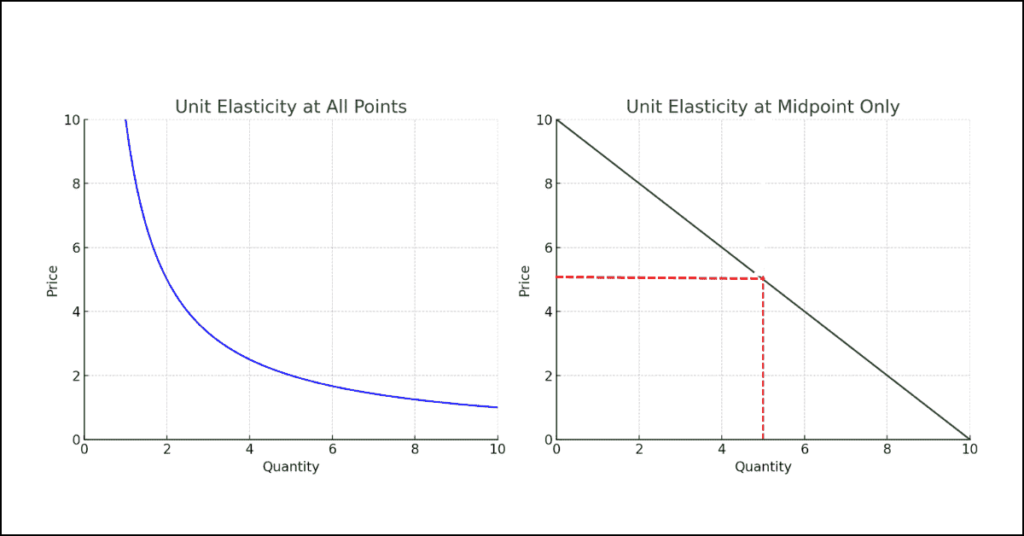
9. Draw a straight line demand curve and show on it a point at which (i) price elasticity of demand > 1 (ii) price elasticity of demand < 1
Answer:
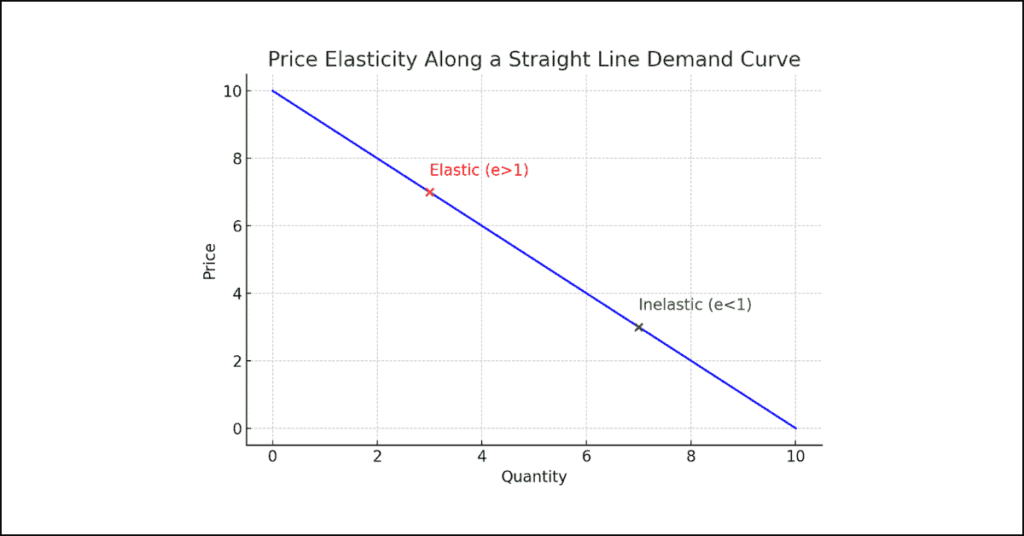
10. Draw a vertical demand curve and state the nature of price elasticity on it.
Answer:
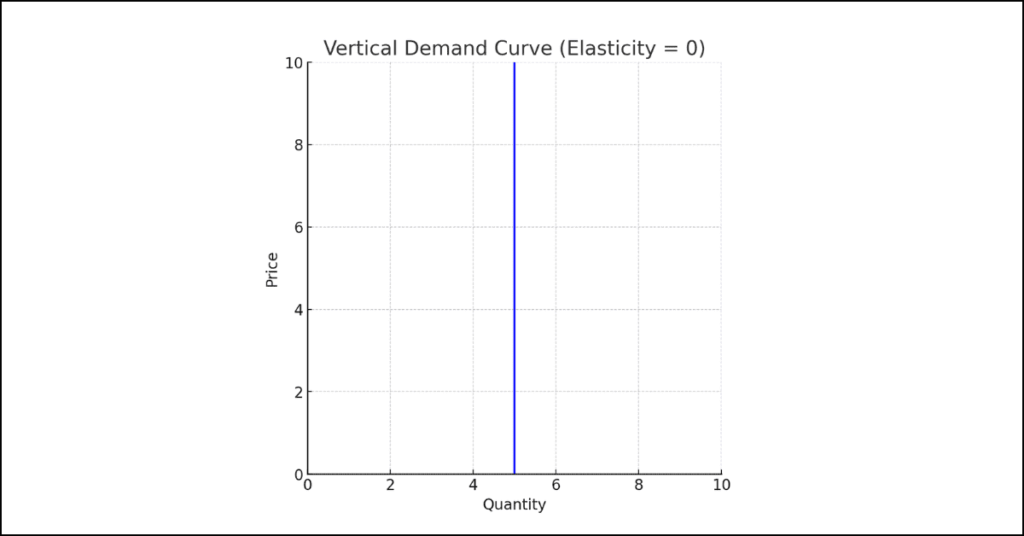
Here is the diagram of a vertical demand curve, which represents perfectly inelastic demand. The price elasticity of demand on this curve is zero (Elasticity = 0) at all points, meaning that changes in price have no effect on the quantity demanded.
Long Answer Type Questions
1. Explain the concept of price elasticity of demand. (AHSEC Question Bank)
Answer: Price elasticity of demand refers to the degree of responsiveness of the demand for a good to a change in its price. In other words, it measures how much the quantity demanded of a good changes when its price changes, other things remaining the same. It is measured as the percentage change in quantity demanded divided by the percentage change in price. The formula for calculating price elasticity of demand is:
Price Elasticity of Demand = Percentage change in quantity demanded / Percentage change in price
The value of price elasticity of demand can vary from zero to infinity. Depending on the value, demand is said to be elastic, inelastic, or unitary elastic.
2. Explain the factors affecting the magnitude of price elasticity of demand.
Answer: The factors affecting the magnitude of price elasticity of demand are as follows:
- Availability of Close Substitutes: If close substitutes of a good are readily available, its price elasticity of demand is likely to be high because consumers can easily switch to other goods in response to price changes. For example, demand for cold drinks like Coca-Cola, Pepsi, etc., is highly elastic due to the availability of substitutes.
- Nature of the Commodity: If the commodity is a necessity of life, its demand will not change much when its price changes, leading to low price elasticity. On the other hand, luxury items tend to have high price elasticity because consumers can postpone their consumption or do without them when prices rise.
- Proportion of Income Spent: The greater the proportion of income spent on a commodity, the more elastic the demand. For example, high-priced items like furniture tend to have elastic demand, while low-priced items like salt or matchboxes tend to have inelastic demand.
- Habitual Consumption: Goods that are habitually consumed tend to have inelastic demand. For instance, smokers may not reduce their consumption of cigarettes even if prices rise.
- Number of Uses: Goods that can be put to multiple uses tend to have elastic demand. For example, when the price of coal rises, people may reduce its use for less important purposes, leading to elastic demand.
- Income of Consumers: The income level of consumers also affects price elasticity. Wealthy consumers are less sensitive to price changes, leading to inelastic demand, whereas poor consumers are more sensitive, leading to elastic demand.
- Postponement of Consumption: If the consumption of a good can be postponed, the demand for it will be elastic. For instance, consumers may delay buying durable goods like cars if their prices rise.
- Time Period: Demand tends to be more elastic in the long run because consumers have more time to find substitutes or adjust their consumption habits.
3. How is price elasticity of demand measured according to percentage method?
Answer: Price elasticity of demand is measured using the percentage method by calculating the ratio of the percentage change in quantity demanded to the percentage change in price. The formula is:
Price Elasticity of Demand (e) = Percentage change in quantity demanded / Percentage change in price
This method expresses both changes (in price and quantity) as percentages, making it easier to compare the two. The percentage changes are calculated as follows:
Percentage change in quantity demanded = (Change in quantity demanded / Original quantity demanded) × 100
Percentage change in price = (Change in price / Original price) × 100
For example, if the quantity demanded of a good increases by 20% in response to a 10% decrease in price, the price elasticity of demand would be:
Price Elasticity of Demand = 20% / 10% = 2
This indicates that demand is elastic, as the percentage change in demand is greater than the percentage change in price.
4. Show and explain how price elasticity of demand is different at different points on the same demand curve. (or) Draw a downward sloping straight line demand curve touching both the axis. mark the price elasticity of demand at different points of this demand curve.
Answer:
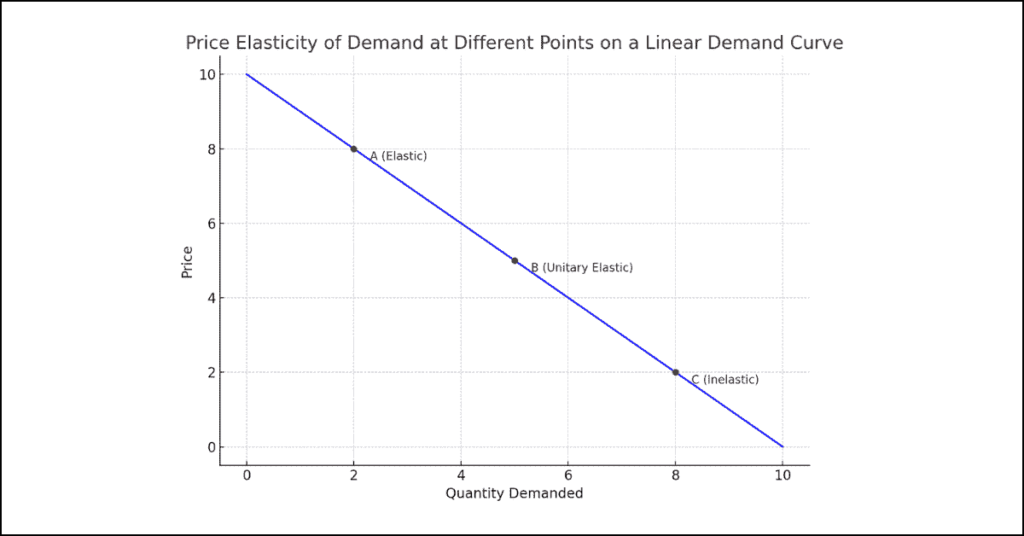
The graph above represents how price elasticity of demand changes at different points along a linear demand curve. Here’s an explanation for each point marked on the curve:
- Point A (Elastic): At this point, demand is elastic. A small change in price leads to a larger percentage change in quantity demanded. As a result, the price elasticity of demand is greater than 1.
- Point B (Unitary Elastic): At the midpoint of the demand curve, the price elasticity of demand is exactly 1. This means that the percentage change in price leads to an equal percentage change in quantity demanded.
- Point C (Inelastic): At this point, demand is inelastic. A change in price results in a smaller percentage change in quantity demanded, meaning that the price elasticity of demand is less than 1.
This demonstrates how price elasticity varies along different points of the same demand curve.
5. Explain by giving examples how do the following determine price elasticity of demand. (i) Nature of the good, (ii) Availability of substitutes.
Answer: (i) Nature of the good: The nature of a good significantly affects its price elasticity of demand. Goods can be classified into necessities, comforts, and luxuries:
- Necessities: Goods that are essential for survival, such as food, water, and medicine, tend to have inelastic demand because people continue to buy them regardless of price changes. For example, the demand for rice is inelastic because it is a staple food.
- Luxuries: Goods that are not essential for survival but provide comfort or pleasure, such as air conditioners or luxury cars, tend to have elastic demand. A rise in price may lead to a significant reduction in the quantity demanded, as people can postpone their consumption or do without them.
(ii) Availability of substitutes: The availability of close substitutes for a good makes its demand more elastic. When substitutes are readily available, even a small increase in price can lead consumers to switch to other goods. For example:
- Cold drinks: The demand for cold drinks like Coca-Cola or Pepsi is highly elastic because there are many substitutes available (e.g., fruit juices, water, other soft drinks). A small price increase may cause consumers to switch to other drinks.
- Electricity: In contrast, the demand for electricity is inelastic because there are no close substitutes for it in most households and industries.
6. Show how the price elasticity of demand is graphically measured along a linear demand curve. (AHSEC 2013)
Answer:
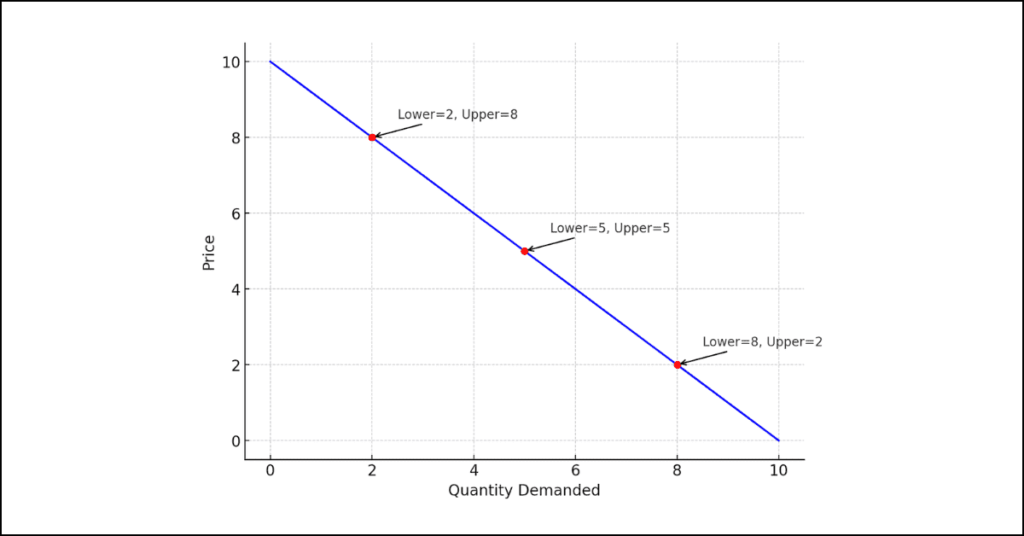
The graph above illustrates how the price elasticity of demand is measured along a linear demand curve. At any given point, the elasticity is determined by the ratio of the lower segment (from the origin to the point) to the upper segment (from the point to the maximum quantity). The annotations highlight this ratio for selected points along the curve.
Numerical Questions
Problem 1(a):
To calculate the price elasticity of demand (eₚ), use the formula:
ep = (ΔQ% / ΔP%)
Given:
- Percentage change in price (ΔP%) = –40%
- Percentage change in quantity demanded (ΔQ%) = +50%
ep = (50% / -40%) = -1.25
Answer: The price elasticity of demand is 1.25.
Problem 1(b):
Given:
- ΔP% = –4%
- ΔQ% = +10%
ep = (10% / -4%) = -2.5
Since the absolute value of eₚ is greater than 1, demand is elastic.
Answer: The price elasticity of demand is 2.5. Demand is elastic.
Problem 2(a):
Given:
- eₚ = 2
- ΔP% = 5%
ΔQ% = ep × ΔP% = 2 × 5% = 10%
Answer: The percentage change in quantity demanded is 10%.
Problem 2(b):
Given:
- eₚ = 0.5
- ΔQ% = 4%
ΔP% = (ΔQ% / ep) = (4% / 0.5) = 8%
Answer: The percentage change in price is 8%.
Problem 3:
Calculate the percentage changes:
ΔQ% = ((15 – 10) / 10) × 100% = 50%
ΔP% = ((5 – 7) / 7) × 100% = -28.57%
ep = (50% / -28.57%) = -1.75
Answer: The price elasticity of demand is approximately 1.75.
Problem 4:
Calculate the percentage changes:
ΔQ% = ((10 – 12) / 12) × 100% = -16.67%
ΔP% = ((5 – 4) / 4) × 100% = 25%
ep = (-16.67% / 25%) = -0.67
Answer: The price elasticity of demand is approximately 0.67.
Problem 5:
Calculate the percentage changes:
ΔQ% = ((15 – 20) / 20) × 100% = -25%
ΔP% = ((8 – 10) / 10) × 100% = -20%
ep = (-25% / -20%) = 1.25
Answer: The price elasticity of demand is 1.25.
Problem 6:
Calculate ΔQ%:
ΔQ% = ((140 – 100) / 100) × 100% = 40%
Given eₚ = 2, calculate ΔP%:
ΔP% = (ΔQ% / ep) = (40% / 2) = 20%
Since quantity increases, price must decrease, so ΔP% = –20%.
Calculate new price:
ΔP = -20% × ₹5 = -₹1
New Price = ₹5 – ₹1 = ₹4
Answer: The consumer will buy 140 units at ₹4 per unit.
Problem 7:
Calculate ΔQ%:
ΔQ% = ((580 – 500) / 500) × 100% = 16%
Given ΔP% = –20%, calculate eₚ:
ep = (16% / -20%) = -0.8
Since |eₚ| < 1, demand is inelastic.
Answer: The price elasticity of demand is 0.8. Demand is inelastic.
Problem 8:
Given eₚ = 0.2 and initial quantity demanded Q₁ = 40 units.
Calculate ΔP%:
ΔP% = ((5 – 10) / 10) × 100% = -50%
Calculate ΔQ%:
ΔQ% = ep × ΔP% = 0.2 × (-50%) = -10%
Since the price decreases, quantity demanded increases by 10%.
Calculate new quantity:
ΔQ = 10% × 40 = 4 units
Q2 = 40 + 4 = 44 units
Answer: The new quantity demanded is 44 units.
Problem 9:
Calculate ΔP%:
ΔP% = ((4 – 5) / 5) × 100% = -20%
Given eₚ = 2, calculate ΔQ%:
ΔQ% = ep × ΔP% = 2 × (-20%) = -40%
Since the price decreases, quantity demanded increases by 40%.
Calculate new quantity:
ΔQ = 40% × 10 = 4 units
Q2 = 10 + 4 = 14 units
Answer: The consumer will now buy 14 units of good X.
Problem 10:
Original expenditure:
E1 = ₹5 × 20 = ₹100
New expenditure:
E2 = ₹120
Calculate new price:
Price2 = ₹120 / 24 = ₹5
Since the price remains the same, ΔP% = 0, so eₚ = 0.
The demand curve is parallel to the X-axis.
Answer: The price elasticity of demand is 0; the demand curve is parallel to the X-axis.
Problem 11:
Original expenditure:
E1 = ₹8 × 14 = ₹112
New expenditure:
E2 = ₹98
Calculate new quantity:
Q2 = ₹98 / ₹7 = 14 units
Quantity demanded remains the same despite the price change, so eₚ = 0.
The demand curve is vertical to the Y-axis.
Answer: The price elasticity of demand is 0; the demand curve is vertical to the Y-axis.
Problem 12:
Calculate expenditures:
E1 = ₹7 × 8 = ₹56
E2 = ₹8 × 7 = ₹56
Total expenditure remains constant, indicating unitary elasticity (eₚ = 1).
The demand curve is a rectangular hyperbola.
Answer: The price elasticity of demand is 1; the demand curve is a rectangular hyperbola.
Problem 13:
Given eₚ = –0.8 and ΔQ% = +20%.
Calculate ΔP%:
ΔP% = (ΔQ% / ep) = (20% / -0.8) = -25%
The negative sign indicates a price decrease.
Answer: The percentage fall in price is 25%.
Extra/additional questions and answers
Coming soon
Get notes of other classes and subjects

